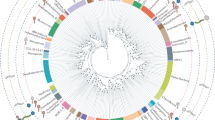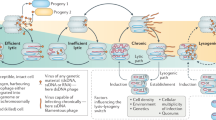Abstract
When viruses were discovered, they were accepted as missing links between the inert world and living organisms. However, this idea was soon abandoned as information about their molecular parasitic nature accumulated. Recently, the notion that viruses are living organisms that have had a role in the evolution of some essential features of cells has experienced a renaissance owing to the discovery of unusually large and complex viruses that possess typical cellular genes. Here, we contend that there is strong evidence against the notion that viruses are alive and represent ancient lineages of the tree of life.
This is a preview of subscription content, access via your institution
Access options
Subscribe to this journal
Receive 12 print issues and online access
$209.00 per year
only $17.42 per issue
Buy this article
- Purchase on Springer Link
- Instant access to full article PDF
Prices may be subject to local taxes which are calculated during checkout


Similar content being viewed by others
References
Muller, H. J. in 4th International Congress of Plant Science 917–918 (ed. Duggar, B. M.) 917–918 (Bantha Publishing, Menasha, 1929)
Podolsky, S. The role of the virus in origin-of-life theorizing. J. Hist. Biol. 29, 79–126 (1996).
Simon, C. E. (ed.) The Filterable Viruses (Reinhold, New York, 1928).
Haldane, J. B. S. The origin of life. Rationalist Ann. 3–10 (1929).
Beutner, R. Life's Beginning on the Earth (Williams and Wilkins, Baltimore, 1938).
Oparin, A. I. Life: its Nature, Origin and Development (Academic Press, New York, 1961).
Avery, O. T., MacLeod, C. M. & McCarty, M. Studies on the chemical nature of the substance inducing transformation of pneumococcal types: induction of transformation by a desoxyribonucleic acid fraction isolated from Pneumococcus type III. J. Exper. Med. 79, 137–158 (1944).
van Regenmortel, M. H. V. in 7th Report of the International Committee on Taxonomy of Viruses (eds van Regenmortel, M. H. V. et al.) 3–16 (Academic Press, San Diego, 2000).
van Regenmortel, M. H. V. in Encyclopedia of Virology (eds Mahy, B. W. J. & van Regenmortel, M. H. V.) 398–402 (Elsevier/Academic Press, 2008).
Bamford, D. H., Grimes, J. M. & Stuart, D. I. What does structure tell us about virus evolution? Curr. Opin. Struct. Biol. 15, 655–663 (2005).
Forterre, P. Three RNA cells for ribosomal lineages and three DNA viruses to replicate their genomes: a hypothesis for the origin of cellular domain. Proc. Natl Acad. Sci. USA 103, 3669–3674 (2006).
La Scola, B. et al. A giant virus in amoebae. Science 299, 2033 (2003).
Raoult, D. et al. The 1.2-megabase genome sequence of Mimivirus. Science 306, 1344–1350 (2004).
Luisi, P. L. About various definitions of life. Orig. Life Evol. Biosph. 28, 613–622 (1998).
Alexander, J. & Bridges, C. B. in Colloid Chemistry, Theoretical and Applied (ed. Alexander, J.) 54 (Reinhold, New York, 1928).
Guerrero, R., Piqueras, M. & Berlanga, M. Microbial mats and the search for minimal ecosystems. Int. Microbiol 5, 177–188 (2002).
Fitch, W. M. Homology a personal view on some of the problems. Trends Genet. 16, 227–231 (2000).
Koonin, E. V., Senkevich, T. G. & Dolja, V. V. The ancient virus world and evolution of cells. Biol. Direct. 1, 29 (2006).
Doolittle, W. F. The nature of the universal ancestor and the evolution of the proteome. Curr. Opin. Struct. Biol. 10, 355–358 (2000).
Ranea, J. A., Sillero, A., Thornton, J. M. & Orengo, C. A. Protein superfamily evolution and the last universal common ancestor (LUCA). J. Mol. Evol. 63, 513–525 (2006).
Raoult, D. & Forterre, P. Redefining viruses: lessons from Mimivirus. Nature Rev. Microbiol. 6, 315–319 (2008).
Benson, S. D., Bamford, J. K., Bamford, D. H. & Burnett, R. M. Does common architecture reveal a viral lineage spanning all three domains of life? Mol. Cell 16, 673–685 (2004).
Rice, G. et al. The structure of a thermophilic archaeal virus shows a double-stranded DNA viral capsid type that spans all domains of life. Proc. Natl Acad. Sci. USA 101, 7716–7720 (2004).
Terada, T. et al. Functional convergence of two lysyl-tRNA synthetases with unrelated topologies. Nature Struct. Biol. 9, 257–262 (2002).
Gherardini, P. F., Wass, M. N., Helmer-Citterich, M. & Sternberg, M. J. Convergent evolution of enzyme active sites is not a rare phenomenon. J. Mol. Biol. 372, 817–845 (2007).
Wales, D. J. The energy landscape as a unifying theme in molecular science. Philos. Transact A Math. Phys. Eng. Sci. 363, 357–375 (2005).
Olson, A. J., Hu, Y. H. & Keinan, E. Chemical mimicry of viral capsid self-assembly. Proc. Natl Acad. Sci. USA 104, 20731–20736 (2007).
Barocchi, M. A., Masignani, V. & Rappuoli, R. Cell entry machines: a common theme in nature? Nature Rev. Microbiol. 3, 349–358 (2005).
Yeates, T. O., Kerfeld, C. A., Heinhorst, S., Cannon, G. C. & Shively, J. M. Protein-based organelles in bacteria: carboxysomes and related microcompartments. Nature Reviews Microbiology 6, 681–691 (2008).
Koonin, E. V. & Dolja, V. V. Evolution of complexity in the viral world: the dawn of a new vision. Virus Res. 117, 1–4 (2006).
Koonin, E. V., Makarova, K. S. & Aravind, L. Horizontal gene transfer in prokaryotes: quantification and classification. Annu. Rev. Microbiol. 55, 709–742 (2001).
Moreira, D. & Brochier-Armanet, C. Giant viruses, giant chimeras: the multiple evolutionary histories of Mimivirus genes. BMC Evol. Biol. 8, 12 (2008).
Gray, M. W. & Doolittle, W. F. Has the endosymbiont hypothesis been proven? Microbiol. Rev. 46, 1–42 (1982).
Woolhouse, M. E., Taylor, L. H. & Haydon, D. T. Population biology of multihost pathogens. Science 292, 1109–1112 (2001).
Coats, D. W. Parasitic life styles of marine dinoflagellates. J. Euk. Microbiol. 46, 402–409 (2007).
Woolhouse, M. E., Haydon, D. T. & Antia, R. Emerging pathogens: the epidemiology and evolution of species jumps. Trends Ecol. Evol. 20, 238–244 (2005).
Ball, A. & Johnson, K. L. in The Insect Viruses (eds. Miller, L. K. & Ball, L. A.) 225–267 (Plenum Publishing, New York, 1998).
Selling, B. H., Allison, R. F. & Kaesberg, P. Genomic RNA of an insect virus directs synthesis of infectious virions in plants. Proc. Natl Acad. Sci. USA 87, 434–438 (1990).
Price, B. D., Rueckert, R. R. & Ahlquist, P. Complete replication of an animal virus and maintenance of expression vectors derived from it in Saccharomyces cerevisiae. Proc. Natl Acad. Sci. USA 93, 9465–9470 (1996).
Prangishvili, D., Forterre, P. & Garrett, R. A. Viruses of the Archaea: a unifying view. Nature Rev. Microbiol. 4, 837–848 (2006).
Cavalier-Smith, T. Membrane heredity and early chloroplast evolution. Trends Plant Sci. 5, 174–182 (2000).
Miller, S. & Krijnse-Locker, J. Modification of intracellular membrane structures for virus replication. Nature Rev. Microbiol. 6, 363–374 (2008).
Peretó, J., López-García, P. & Moreira, D. Ancestral lipid biosynthesis and early membrane evolution. Trends Biochem. Sci. 29, 469–477 (2004).
Dinsdale, E. A. et al. Functional metagenomic profiling of nine biomes. Nature 452, 629–632 (2008).
Mann, N. H., Cook, A., Millard, A., Bailey, S. & Clokie, M. Marine ecosystems: bacterial photosynthesis genes in a virus. Nature 424, 741 (2003).
McClure, M. A. Evolution of the DUT gene: horizontal transfer between host and pathogen in all three domains of Life. Curr. Protein Pept. Sci. 2, 313–324 (2001).
Bratke, K. A. & McLysaght, A. Identification of multiple independent horizontal gene transfers into poxviruses using a comparative genomics approach. BMC Evol. Biol. 8, 67 (2008).
Moreira, D. & López-García, P. Comment on “The 1.2-megabase genome sequence of Mimivirus”. Science 308, 1114 (2005).
Shutt, T. E. & Gray, M. W. Bacteriophage origins of mitochondrial replication and transcription proteins. Trends Genet. 22, 90–95 (2006).
Moreira, D. Multiple independent horizontal transfers of informational genes from bacteria to plasmids and phages: implications for the origin of bacterial replication machinery. Mol. Microbiol. 35, 1–5 (2000).
Drake, J. W., Charlesworth, B., Charlesworth, D. & Crow, J. F. Rates of spontaneous mutation. Genetics 148, 1667–1686 (1998).
Awadalla, P. The evolutionary genomics of pathogen recombination. Nature Rev. Genet. 4, 50–60 (2003).
Forterre, P. The origin of viruses and their possible roles in major evolutionary transitions. Virus Res. 117, 5–16 (2006).
Yin, Y. & Fischer, D. On the origin of microbial ORFans: quantifying the strength of the evidence for viral lateral transfer. BMC Evol. Biol. 6, 63 (2006).
Suttle, C. A. Marine viruses—major players in the global ecosystem. Nature Rev. Microbiol. 5, 801–812 (2007).
Zhaxybayeva, O. & Gogarten, J. P. Cladogenesis, coalescence and the evolution of the three domains of life. Trends Genet. 20, 182–187 (2004).
Lwoff, A. L'évolution physiologique. Etude des Pertes de Fonctions Chez les Microorganismes (Hermann et Cie, Paris, 1943).
Iyer, L. M., Balaji, S., Koonin, E. V. & Aravind, L. Evolutionary genomics of nucleo-cytoplasmic large DNA viruses. Virus Res. 20, 20 (2006).
Diener, T. O. Circular RNAs: relics of precellular evolution? Proc. Natl Acad. Sci. USA 86, 9370–9374 (1989).
Claverie, J. M. Viruses take center stage in cellular evolution. Gen. Biol. 7, 110 (2006).
Novoa, R. R. et al. Virus factories: associations of cell organelles for viral replication and morphogenesis. Biol. Cell 97, 147–172 (2005).
Futse, J. E., Brayton, K. A., Dark, M. J., Knowles, D. P. Jr & Palmer, G. H. Superinfection as a driver of genomic diversification in antigenically variant pathogens. Proc. Natl Acad. Sci. USA 105, 2123–2127 (2008).
Aristotle, D.a. De anima (350 BC) (ed. Hick, R. D.) (George Olms Verlag, Hildesheim, 1990).
Engels, F. Herrn Eugen Dühring's Umwälzung der Wissenschaft (Dietz Verlag, Stuttgart, 1894).
Schrödinger, E. What is Life? (Cambridge University Press, Cambridge, 1944).
Von Neumann, J. in Lectures on the Theory and Organisation of Complicated Automata (ed. Burks, A. W.) (University of Illinois Press, Urbana 1949).
de Duve, C. Blueprint for a Cell (Patterson, Burlington 1991).
Prigogine, I. Introduction to Thermodynamics of Irreversible Processes (Wiley, New York, 1961).
Bernal, J. D. in Theoretical and Mathematical Biology (eds. Waterman, T. & Morowitz, H. J.) 96–135 (Blaisdell, New York, 1965).
Gánti, T. The Principles of Life (Oxford University Press, Oxford, 2003).
Varela, F. G., Maturana, H. R. & Uribe, R. Autopoiesis: the organization of living systems, its characterization and a model. Curr. Mod. Biol. 5, 187–196 (1974).
Maynard Smith, J. The Problems of Biology (Oxford University Press, Oxford, 1986).
Joyce, G. F. in Origins of Life: the Central Concepts (eds Deamer, D. W. & Fleischaker, G. R.) xi–xii (Jones & Bartlett, Boston, 1994).
Ruiz-Mirazo, K., Pereto, J. & Moreno, A. A universal definition of life: autonomy and open-ended evolution. Orig. Life Evol. Biosph. 34, 323–346 (2004).
Acknowledgements
The authors thank three anonymous referees for helpful comments and criticisms, T.O. Yeates and S.W. Wilhelm for permission to use the photographs shown in Figure 1, and the French Agence Nationale de la Recherche (ANR JC05_44,674) and the CNRS for financial support.
Author information
Authors and Affiliations
Corresponding author
Ethics declarations
Competing interests
The authors declare no competing financial interests.
Related links
Rights and permissions
About this article
Cite this article
Moreira, D., López-García, P. Ten reasons to exclude viruses from the tree of life. Nat Rev Microbiol 7, 306–311 (2009). https://doi.org/10.1038/nrmicro2108
Published:
Issue Date:
DOI: https://doi.org/10.1038/nrmicro2108
This article is cited by
-
What is life?
Molecular Biology Reports (2021)
-
Beyond categorical definitions of life: a data-driven approach to assessing lifeness
Synthese (2021)
-
The Origin(s) of Cell(s): Pre-Darwinian Evolution from FUCAs to LUCA
Journal of Molecular Evolution (2021)
-
Evolutionary entanglement of mobile genetic elements and host defence systems: guns for hire
Nature Reviews Genetics (2020)
-
The LUCA and its complex virome
Nature Reviews Microbiology (2020)



